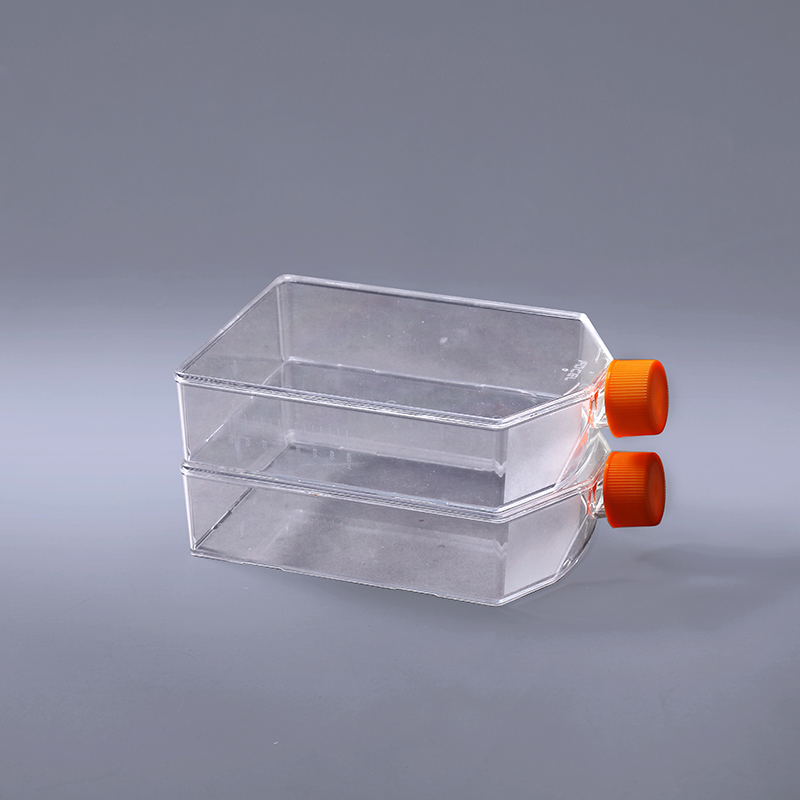ทำจากวัสดุโพลีสไตรีนเกรดทางการแพทย์ที่มีความโปร่งใสสูง ตามกระบวนการบำบัดพื้นผิวที่แตกต่างกัน มันถูกแบ่งออกเป็นสองประเภท: ชอบน้ำ และไม่ชอบน้ำ.: ใช้สำหรับการเพาะเลี้ยงเซลล์ที่ยึดเกาะ การเจริญเติบโตของเซลล์ดังกล่าวต้องมีพื้นผิวรองรับที่สามารถยึดติดได้ และเซลล์สามารถเติบโตและขยายพันธุ์บนพื้นผิวนี้ได้โดยอาศัยปัจจัยการยึดติดที่หลั่งออกมาเองหรือจัดเตรียมไว้ในอาหารเลี้ยงเชื้อ พื้นผิวของขวดได้รับการปรับปรุงเป็นพิเศษเพื่อแนะนำกลุ่มที่ชอบน้ำ จุดประสงค์คือเพื่อเพิ่มประสิทธิภาพการยึดเกาะของพื้นผิวขวดซึ่งเหมาะสำหรับการเจริญเติบโตของเซลล์มากกว่าขวดเพาะเลี้ยงเซลล์
ข้างต้นเป็นขวดเพาะเลี้ยงเซลล์สองประเภท ซึ่งส่วนใหญ่เหมาะสำหรับขนาดกลาง การเพาะเลี้ยงเซลล์และเนื้อเยื่อในห้องปฏิบัติการ การออกแบบคอขวดที่กว้างช่วยให้ปิเปตและที่ขูดเซลล์สามารถสัมผัสกับพื้นผิวที่มีการเจริญเติบโตได้ขวดเพาะเลี้ยงเซลล์ที่ไม่ชอบน้ำ
The above are two types of cell culture flasks, which are mainly suitable for medium-scale cell and tissue culture in the laboratory. The wide bottleneck design facilitates the pipette and cell scraper to contact the growth surface.
The FAI climbed 5.9 percent year-on-year in the first 11 months of 2018, quickening from the 5.7-percent growth in Jan-Oct, the National Bureau of Statistics (NBS) said Friday in an online statement.
The key indicator of investment, dubbed a major growth driver, hit the bottom in August and has since started to rebound steadily.
In the face of emerging economic challenges home and abroad, China has stepped up efforts to stabilize investment, in particular rolling out measures to motivate private investors and channel funds into infrastructure.
Friday's data showed private investment, accounting for more than 60 percent of the total FAI, expanded by a brisk 8.7 percent.
NBS spokesperson Mao Shengyong said funds into weak economic links registered rapid increases as investment in environmental protection and agriculture jumped 42 percent and 12.5 percent respectively, much faster than the average.
In breakdown, investment in high-tech and equipment manufacturing remained vigorous with 16.1-percent and 11.6-percent increases respectively in the first 11 months. Infrastructure investment gained 3.7 percent, staying flat. Investment in property development rose 9.7 percent, also unchanged.
 English
English



















































